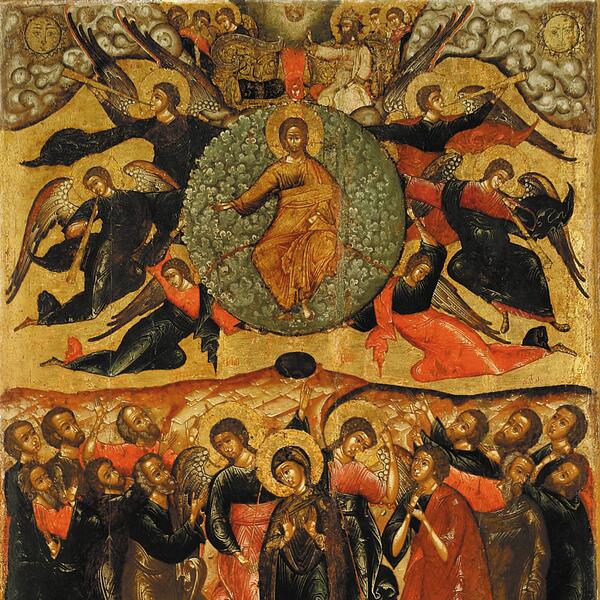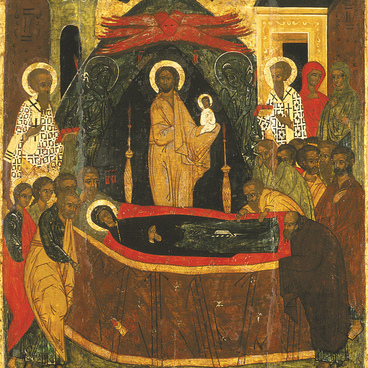Most likely, the Feast of the Ascension of Jesus was established as early as the 4th century. This event was foretold by Jesus long before the crucifixion and was described in detail in the Gospels according to Luke and Mark, and in the Acts of the Apostles.
After being executed and having resurrected, Jesus repeatedly appeared to his disciples, to maintain and strengthen their faith and prepare them for the descent of the Holy Spirit. In Bethany, a village on the Mount of Olives, he was “exalted by the right hand of God” (Acts 2:33). Two angels appeared before the terrified apostles and announced to them that at the end of time the Savior would return in the same way to judge the living and the dead.
Until the mid-4th century, the Ascension and the Pentecost were celebrated as a single feast. According to the Apostolic Constitutions, since around 380, the Feast of the Ascension was celebrated on the fortieth day of Easter. In the mid-14th century, the images of Ascension entered the feast tier of tall Russian iconostases.
This icon had a rather constant iconography. The Mother of God stands in the middle, either facing the viewer or inclining her head as in this icon. As a rule, she lifts her hands in prayer or folds them on her chest with the palms facing the viewer. Two angels stand on either side of her, pointing at the sky and referring to the words of the Ascension hymn, “For She who suffered the greatest sorrows during Your agony/ shall now find the greatest joy/ in Your glory.”
Twelve apostles may be depicted in two groups either standing or moving. In this case, their figures and faces are rather static, with their hands raised or folded in prayer, but their poses still reveal a burst of emotions.
The angels could be depicted in various ways: wearing light or darker clothes, with their hands up or down by their sides. At the top of the icon, angels either levitate on both sides of the mandorla taking Jesus to Heaven, or hold it almost blending with the clouds into one composition element. The Savior sits enthroned and blesses those who stand below. He wears a chiton and a himation of a golden yellow color that symbolizes the divine light.
Interestingly, the viewer’s attention is focused on the lower or “earthly” part of the icon. This is intentional. Both the iconographical canon and the texts of the Gospels focus not only on the Ascension itself but on the importance of this miracle for the Church and the entire Christian world.
This is the earliest Yaroslavl icon to depict a stone with the footprints of Jesus Christ. Later, this detail became widespread in the local iconography of the Ascension.
After being executed and having resurrected, Jesus repeatedly appeared to his disciples, to maintain and strengthen their faith and prepare them for the descent of the Holy Spirit. In Bethany, a village on the Mount of Olives, he was “exalted by the right hand of God” (Acts 2:33). Two angels appeared before the terrified apostles and announced to them that at the end of time the Savior would return in the same way to judge the living and the dead.
Until the mid-4th century, the Ascension and the Pentecost were celebrated as a single feast. According to the Apostolic Constitutions, since around 380, the Feast of the Ascension was celebrated on the fortieth day of Easter. In the mid-14th century, the images of Ascension entered the feast tier of tall Russian iconostases.
This icon had a rather constant iconography. The Mother of God stands in the middle, either facing the viewer or inclining her head as in this icon. As a rule, she lifts her hands in prayer or folds them on her chest with the palms facing the viewer. Two angels stand on either side of her, pointing at the sky and referring to the words of the Ascension hymn, “For She who suffered the greatest sorrows during Your agony/ shall now find the greatest joy/ in Your glory.”
Twelve apostles may be depicted in two groups either standing or moving. In this case, their figures and faces are rather static, with their hands raised or folded in prayer, but their poses still reveal a burst of emotions.
The angels could be depicted in various ways: wearing light or darker clothes, with their hands up or down by their sides. At the top of the icon, angels either levitate on both sides of the mandorla taking Jesus to Heaven, or hold it almost blending with the clouds into one composition element. The Savior sits enthroned and blesses those who stand below. He wears a chiton and a himation of a golden yellow color that symbolizes the divine light.
Interestingly, the viewer’s attention is focused on the lower or “earthly” part of the icon. This is intentional. Both the iconographical canon and the texts of the Gospels focus not only on the Ascension itself but on the importance of this miracle for the Church and the entire Christian world.
This is the earliest Yaroslavl icon to depict a stone with the footprints of Jesus Christ. Later, this detail became widespread in the local iconography of the Ascension.



